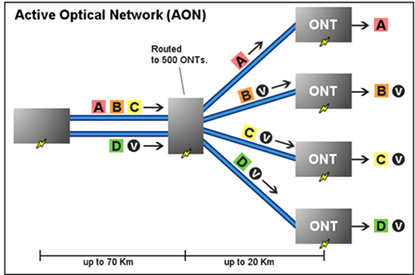The deployment of FTTH (Fiber To The Home) access networks has come a long way before subscribers use optical fibers instead of copper lines to achieve broadband Internet access. FTTH is a form of fiber-optic communication delivery that reaches one living or working space. The fiber extends from the central office to the subscriber’s living or working space. There are two common systems available in FTTH networks: AON (active optical network) and PON (passive optical network).
The AON arrangement is a point-to-point structure (PTP), meaning that each user has his own dedicated fiber optical line terminated on an optical concentrator. In an active optical system, environmentally electrical switching equipment are deployed, such as a router or a switch aggregator, to manage signal distribution and route data to proper places. The following figure show an AON system.

Passive optical network, just as its name shows, it only uses fiber and passive components like optical splitters rather than active components like amplifiers, repeaters, or shaping circuits. Its arrangement is a point to multi-point (PMP) network. That is to say a passive optical network shares fiber optic strands for portions of the network. In passive optical system, a single fiber from a central office optical line terminal (OLT) is connected to optical network terminals (ONTs) or optical network units (ONUs) at customer premises. The image below is a PON system.

An OLT terminates the optical signals and distributes IT and Internet services to as many as 16 to 128 customers per fiber line. An optical splitter, also called PON splitter, is either fitted in or outside the subscriber’s premise to divide a single optical signal into multiple equal but lower-power signals and distribute the signals to users. An optical network unit (ONU) terminates the PON at the customer’s home. The ONU usually communicates with an optical network terminal (ONT), which may be a separate box that connects the PON to TV sets, telephones, computers, or a wireless router. ONU and ONT are basically the same device.
Each system has its own virtual points and shortcomings. As for AON subscribers, the bandwidth in each port is dedicated to each individual without sharing of it. Thus, higher bandwidth per port is possible through AON compared with PON. In addition, because of its dedication to specific individual, it is easier to detect fiber faults or problems in AON. However, an AON system requires active equipment to manage signal transmission, which means power supply and potentially higher costs.
On one hand, a PON system is free from active parts or electronics, so it is less possible that passive parts go wrong in their normal operation, giving rise to a lower cost relative to maintenance of PON system. Besides, PON is efficient since each fiber optic strand can serve up to many users. On the other hand, because the bandwidth in PON is not dedicated to individuals, it is more difficult to figure out failures when disturbances of fibers occur. What’s more, the share of fiber optic strands for portions of the network needs PON subscribers to be geographically closer to the central source of the data, likely that subscribers enjoy a slowdown data transmission with a distance limitation up to 20 km.
Both AON and PON provide feasible solutions for FTTH network connection. They are growing in popularity as the demands for greater bandwidth increase. FS.COM offers several PON equipment for FTTH network, such as PON splitters, OLTs, ONUs, and ONTs. Please visit www.fs.com for more information about PONs and buy FTTH splitter or FTTH ONU.
Related Post: FTTH Access Network Based on GPON